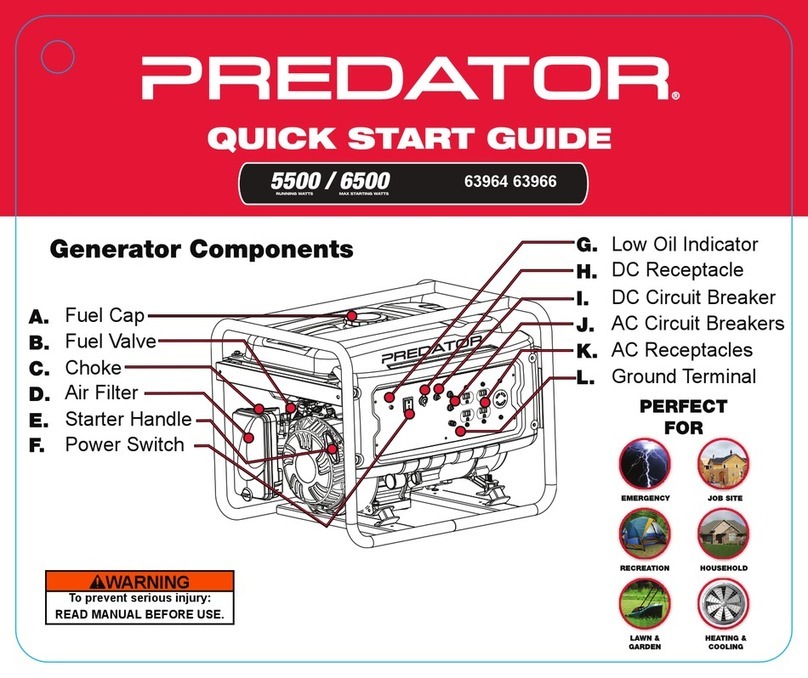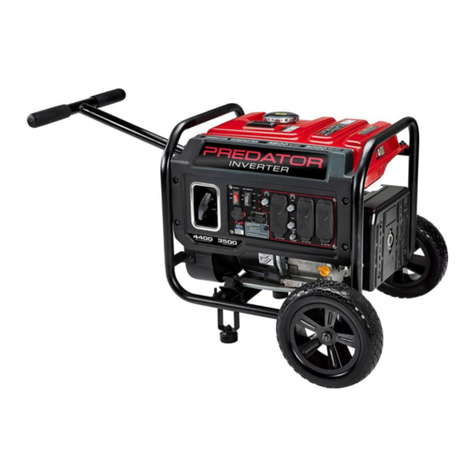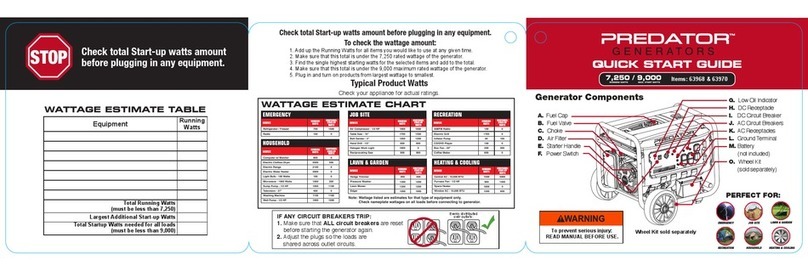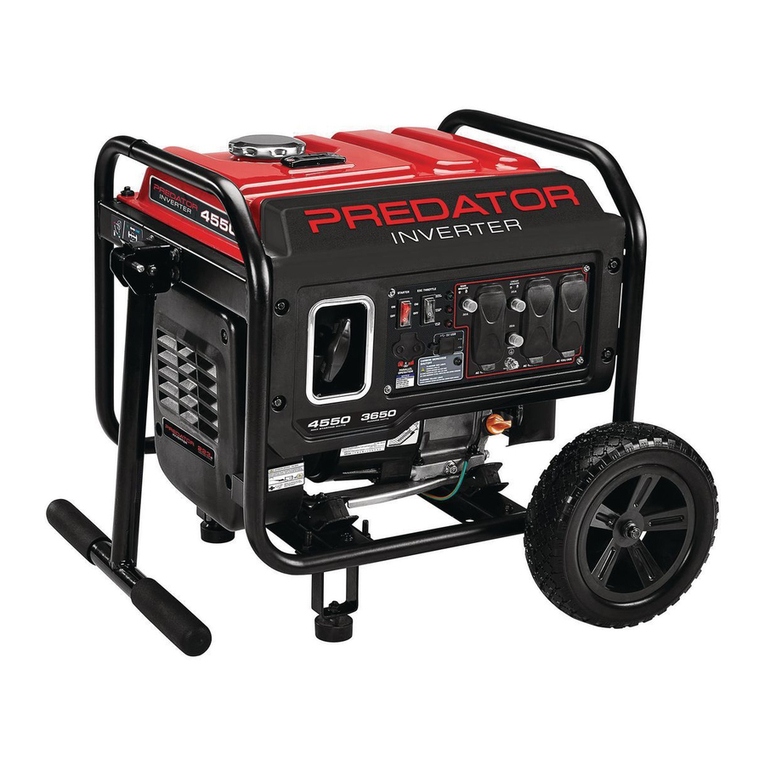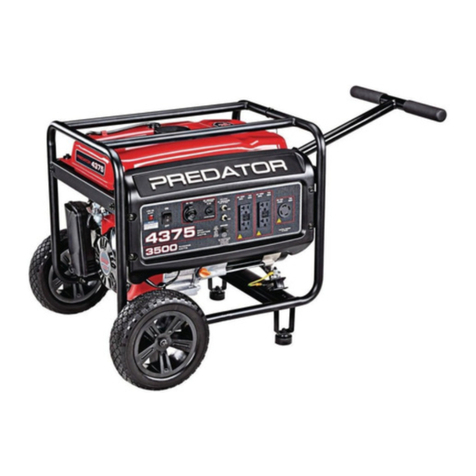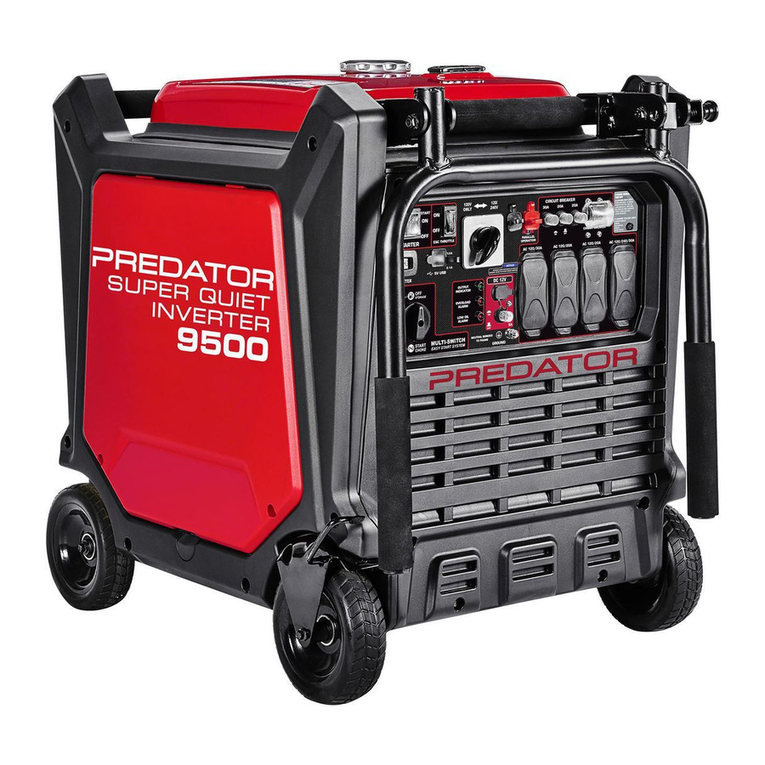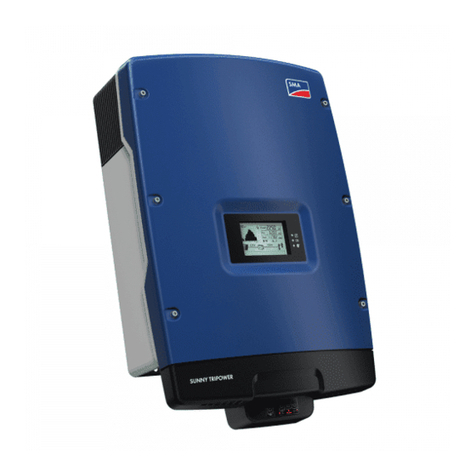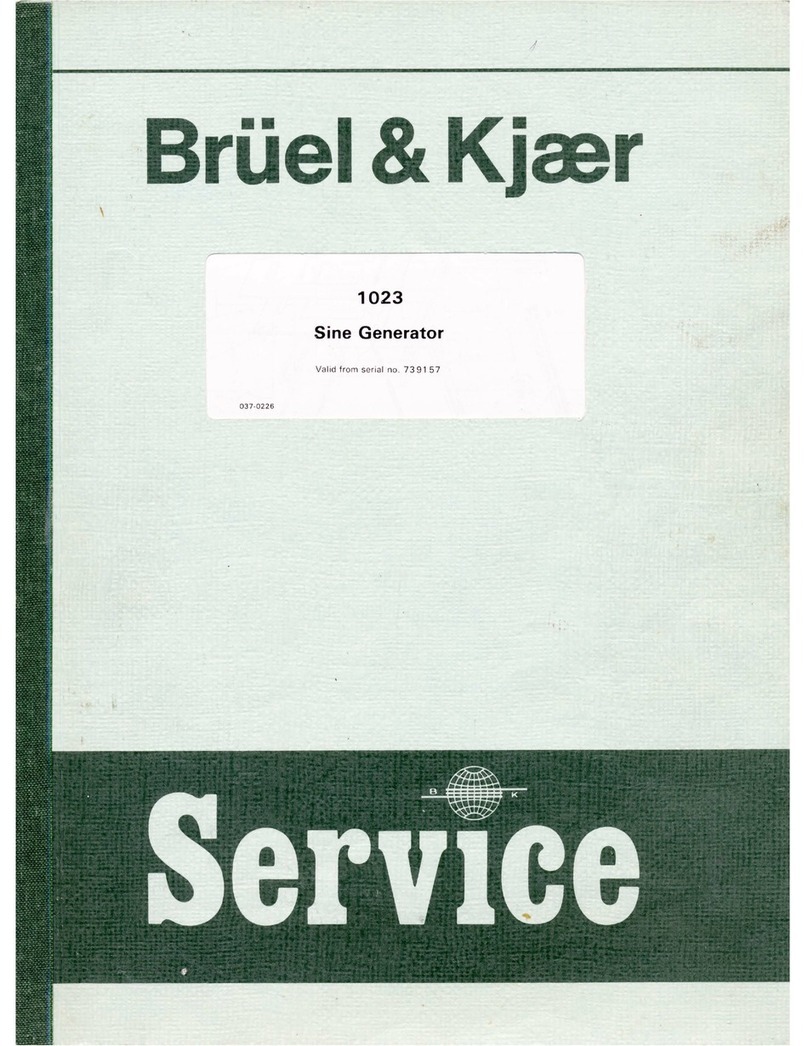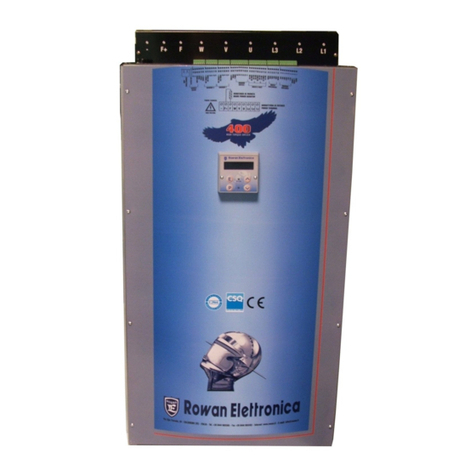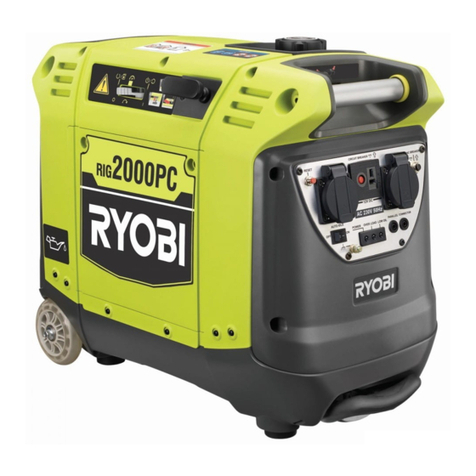Predator 59186 Assembly instructions

1400 WATT
INVERTER
GENERATOR
1100 RUNNING WATTS
1400 MAX STARTING WATTS
SUPER QUIET INVERTER
Visit our website at: http://www.harborfreight.com
Owner’s Manual & Safety Instructions
Save This Manual Keep this manual for the safety warnings and precautions, assembly,
operating, inspection, maintenance and cleaning procedures. Write the product’s serial number in the
back of the manual (or month and year of purchase if product has no number). Keep this manual and the
receipt in a safe and dry place for future reference. 23l
Using a generator indoors CAN
KILL YOU IN MINUTES.
Generator exhaust contains carbon monoxide.
This is a poison you cannot see or smell.
NEVER use inside
a home or garage,
EVEN IF doors and
windows are open.
Only use OUTSIDE
and far away from
windows, doors,
and vents.
When unpacking, make sure that the product is intact
and undamaged. If any parts are missing or broken,
please call 1-888-866-5797 as soon as possible.
Copyright©2021 by Harbor Freight Tools®. All rights reserved.
No portion of this manual or any artwork contained herein may be reproduced in
any shape or form without the express written consent of Harbor Freight Tools.
Diagrams within this manual may not be drawn proportionally. Due to continuing
improvements, actual product may differ slightly from the product described herein.
Tools required for assembly and service may not be included.
Read this material before using this product.
Failure to do so can result in serious injury.
SAVE THIS MANUAL.
Do not use in
trailers, truck
beds, or tents.
Use at least 20 feet away from
people, animals, and structures
with exhaust pointed away.
20′
20′
20′
20′
20′

Page 2 For technical questions, please call 1-888-866-5797. ITEM 59186
Table of Contents
Specifications ...............................................................2
Safety ...........................................................................3
Setup ............................................................................8
Operation..................................................................... 11
Maintenance................................................................ 17
Troubleshooting........................................................... 21
Parts Lists and Diagrams ............................................ 24
Warranties ...................................................................28
Specifications
Generator
Output
120 VAC, 60 Hz, 9.2 A, 1 Phase
12 VDC, 5 A (nominal)
1100 Running Watts
1400 Maximum Starting Watts
Receptacles
2 x 120 VAC, 20 A
1 x 12 VDC, 5 A
2 x USB Port, 2.1 A and 1 A
1 x Parallel Port
Displacement 54 cc
Compression Ratio 8.5:1
Battery Type CR2032, 3V. Contains non-replaceable battery.
Engine Type Horizontal Single Cylinder
4-stroke, OHV
Cooling System Forced air cooled
Fuel Type 87+ octane, stabilizer-treated unleaded gasoline
Capacity 0.74 Gallon / 2.80 Liter
Engine Oil Type SAE 10W-30
Capacity 0.26 qt
Run Time @ 25% Load
with full tank 7.3 hr.
Sound Level 60 dB(A) at 23 ft. (25% Load)
Bore x Stroke 43.5 mm x 36 mm
Spark Plug Type A5RTC (Torch) or equivalent
Gap 0.024"– 0.028"
Valve Clearance Intake 0.0023″ - 0.0039″
Exhaust 0.003"– 0.0047″
Engine Speed 3600 – 5000 RPM
The emissions control system for this Engine is warranted for standards set by the
U.S. Environmental Protection Agency. For warranty information, refer to the last pages of this manual.

Page 3
For technical questions, please call 1-888-866-5797.
ITEM 59186
SAFETYOPERATIONMAINTENANCE SETUP
WARNING SYMBOLS AND DEFINITIONS
This is the safety alert symbol. It is used to alert you to potential
personal injury hazards. Obey all safety messages that
follow this symbol to avoid possible injury or death.
Indicates a hazardous situation which, if not avoided,
will result in death or serious injury.
Indicates a hazardous situation which, if not avoided,
could result in death or serious injury.
Indicates a hazardous situation which, if not avoided,
could result in minor or moderate injury.
Addresses practices not related to personal injury.
Symbol Definitions
Symbol Property or Statement
RPM Revolutions Per Minute
HP Horsepower
AWG American Wire Gauge
WARNING marking concerning
Risk of Eye Injury. Wear ANSI-approved
safety goggles with side shields.
Read the manual before
set-up and/or use.
Symbol Property or Statement
WARNING marking concerning
Risk of Hearing Loss.
Wear hearing protection.
WARNING marking concerning
Risk of Respiratory Injury.
Operate engine OUTSIDE and far away
from windows, doors, and vents.
WARNING marking concerning
Risk of Fire while handling fuel.
Do not smoke while handling fuel.
WARNING marking concerning
Risk of Fire. Do not refuel while
operating. Keep flammable
objects away from engine.
IMPORTANT SAFETY INSTRUCTIONS
WARNING! Read all instructions.
Failure to follow all instructions listed below may result in fire, serious injury and/or DEATH.
The warnings and precautions discussed in this manual cannot cover all possible conditions and
situations that may occur. It must be understood by the operator that common sense and caution
are factors which cannot be built into this product, but must be supplied by the operator.
SAVE THESE INSTRUCTIONS

Page 4 For technical questions, please call 1-888-866-5797. ITEM 59186
SAFETY OPERATION MAINTENANCESETUP
Setup Precautions
1. Gasoline fuel and fumes are flammable, and
potentially explosive. Use proper fuel storage
and handling procedures. Do not store fuel
or other flammable materials nearby.
2. Have multiple ABC class fire extinguishers nearby.
3. Operation of this equipment may create sparks that
can start fires around dry vegetation.
A spark arrestor may be required. The operator
should contact local fire agencies for laws or
regulations relating to fire prevention requirements.
4. Set up and use only on a flat, level,
well-ventilated surface.
5. All connections and conduits from the Generator
to the load must only be installed by trained and
licensed electricians, and in compliance with all
relevant local, state, and federal electrical codes and
standards, and other regulations where applicable.
6. Connections for standby power to a building
electrical system must be made by a qualified
electrician. The connection must isolate the
Generator power from utility power, and must
comply with all applicable laws and electrical codes.
7. A transfer switch should be installed by a
licensed electrician in compliance with all
applicable laws and electrical codes.
8. Wear ANSI-approved safety goggles, heavy-duty
work gloves, and dust mask/respirator during set up.
9. Use only lubricants and fuel recommended
in the Specifications chart of this manual.
10. Improper connections to a building electrical system
can allow electrical current from the Generator
to backfeed into the utility lines. Such backfeed
may electrocute utility company workers or others
who contact the lines during a power outage,
and the Generator may explode, burn, or cause
fires when utility power is restored. Consult
the utility company and a qualified electrician if
intending to use the Generator for back up power.
11. Do not operate the Generator before grounding.
The Generator must be earth-grounded
in accordance with all relevant electrical
codes and standards before operation.
12. Install carbon monoxide alarm(s) with
battery backup in nearby buildings according
to manufacturer’s instructions.
Operating Precautions
1. CARBON MONOXIDE HAZARD
Using a generator indoors CAN KILL
YOU IN MINUTES.
Generator exhaust contains
carbon monoxide. This is a poison
you cannot see or smell.
OFF
RUN
START
LOWOIL OVERLOADOUTPUT
PARALLELOUTLETS
RESET
AC120V
RESET
DC12V
ESC
THROTTLE
OFF
RUN
START
LOWOIL OVERLOADOUTPUT
PARALLELOUTLETS
RESET
AC120V
RESET
DC12V
ESC
THROTTLE
NEVER use inside a home or garage,
EVEN IF doors and windows are open.
OFF
RUN
START
LOWOIL OVERLOADOUTPUT
PARALLELOUTLETS
RESET
AC120V
RESET
DC12V
ESC
THROTTLE
Only use OUTSIDE and far away from windows,
doors, and vents.
2. CARBON MONOXIDE SHUTOFF
DANGER! TO PREVENT SERIOUS
INJURY AND DEATH FROM
CARBON MONOXIDE INHALATION:
The Carbon Monoxide sensor is an additional
layer of protection only. Do not use the
Generator in any area or situation that will
allow carbon monoxide to accumulate.
• FLASHING RED LIGHT:
Dangerous levels of carbon monoxide gas have
built up and generator will shutoff.
Leave immediately until area has aired
out. Move Generator to well-ventilated
area before operation.
• FLASHING YELLOW LIGHT:
Carbon monoxide sensor malfunction.
Sensor needs service. Do not use the
Generator until the sensor is working
properly. For technical questions, please call
1-888-866-5797.
NOTE: Yellow light flashes once
after starting to indicate passing self-
check and is functioning normally.
Carbon Monoxide sensor must only be serviced
by qualified technician to restore it to original
settings. Do not modify or tamper with the
Carbon Monoxide sensor. Not following these
instructions can result in death or serious injury
due to Carbon Monoxide sensor malfunction.
3. Never use a generator indoors, including in
garages, basements, crawl spaces and sheds.
Opening doors and windows or using fans will NOT
prevent carbon monoxide build up in the home.
4. When using generators, keep them outdoors
and far away from open doors, windows,
and vents to avoid toxic levels of carbon
monoxide from building up indoors.

Page 5
For technical questions, please call 1-888-866-5797.
ITEM 59186
SAFETYOPERATIONMAINTENANCE SETUP
5. If you start to feel sick, dizzy, or weak while
using a generator, get to fresh air right away.
The carbon monoxide from generators can
quickly lead to full incapacitation and death.
6. Keep children away from the equipment,
especially while it is operating.
7. Keep all spectators at least six feet
from the engine during operation.
8. Fire Hazard! Do not fill gas tank while engine is
running. Do not operate if gasoline has been spilled.
Clean spilled gasoline before starting engine.
Do not operate near pilot light or open flame.
9. Do not touch engine during use.
Let engine cool down after use.
10. Never store fuel or other flammable
materials near the engine.
11. If the plugged in product operates abnormally
or unusually slow, immediately stop using the
generator as a power source. Read and adhere
to the instruction manual of the product to be
powered to make sure that it can be safely and
efficiently powered by a portable generator.
12. Before connecting an appliance or power cord
to the generator: Make sure that it is in good
working order. Faulty appliances or power cords
can create a potential for electrical shock.
13. Do not exceed the running wattage of the generator.
Make sure that the total electrical rating of the
all of the tools or appliances plugged into the
generator at the same time does not exceed that
of the generator. Check that the startup surge
will not be beyond the limit of the generator.
14. Avoid substantially overloading which will trip
the circuit breaker. Slightly overloading the
generator may not trip the circuit breaker,
but will lead to premature generator failure.
15. Do not attempt to connect or disconnect
load connections while standing in water,
or on wet or soggy ground.
16. Do not touch electrically energized parts of
the generator and interconnecting cables or
conductors with any part of the body, or with
any non-insulated conductive object.
17. Connect the generator only to a load that is
compatible with the electrical characteristics
and running wattage of the generator.
18. Insulate all connections and disconnected wires.
19. Guard against electric shock.
Prevent body contact with grounded surfaces such
as pipes, radiators, ranges, and refrigerators.
20. Only use a suitable means of transport and
lifting devices with sufficient weight bearing
capacity when transporting the generator.
21. Secure the generator on transport vehicles to
prevent it from rolling, slipping, and tilting.
22. Industrial applications must follow
OSHA requirements.
23. Do not leave the generator unattended when it is
running. Turn off the generator (and remove safety
keys, if available) before leaving the work area.
24. The generator can produce high noise levels.
Prolonged exposure to noise levels
above 85 dBA is hazardous to hearing.
Wear ear protection when operating the generator
or when working nearby while it is operating.
25. Keep access doors on enclosures locked.
26. Wear ANSI-approved safety glasses
and hearing protection during use.
27. People with pacemakers should consult their
physician(s) before use. Electromagnetic fields in
close proximity to a heart pacemaker could cause
pacemaker interference or pacemaker failure.
Caution is necessary when near the
engine’s magneto or recoil starter.
28. Use only accessories that are recommended
by Harbor Freight Tools for your model.
Accessories that may be suitable for one
piece of equipment may become hazardous
when used on another piece of equipment.
29. Do not operate in explosive atmospheres,
such as in the presence of flammable
liquids, gases, or dust. Gasoline-powered
engines may ignite the dust or fumes.
30. Stay alert, watch what you are doing and
use common sense when operating this
generator. Do not use while tired or under the
influence of drugs, alcohol or medication.
31. Dress properly. Do not wear loose clothing or
jewelry. Keep hair, clothing and gloves away
from moving parts. Loose clothes, jewelry or
long hair can be caught in moving parts.
32. Parts, especially exhaust system components,
get very hot during use. Stay clear of hot parts.
33. Do not cover the generator during operation.
34. Keep the generator and surrounding area
clean at all times. Keep generator at least
5 feet from combustible objects.
35. Do not smoke, or allow sparks, flames,
or other sources of ignition around the
equipment, especially when refuelling.
36. Use the equipment, accessories, etc.,
in accordance with these instructions and in
the manner intended for the particular type of
equipment, taking into account the working
conditions and the work to be performed.
Use of the equipment for operations different from
those intended could result in a hazardous situation.
37. Do not operate the equipment with known
leaks in the engine’s fuel system.
38. When spills of fuel or oil occur, they must be
cleaned up immediately. Dispose of fluids and
cleaning materials as per any local, state, or
federal codes and regulations. Store oil rags in
a bottom-ventilated, covered, metal container.

Page 6 For technical questions, please call 1-888-866-5797. ITEM 59186
SAFETY OPERATION MAINTENANCESETUP
39. Keep hands and feet away from moving parts.
Do not reach over or across
equipment while operating.
40. Before use, check for misalignment or binding of
moving parts, breakage of parts, and any other
condition that may affect the equipment’s operation.
If damaged, have the equipment serviced
before using. Many accidents are caused
by poorly maintained equipment.
41. Use the correct equipment for the application.
Do not modify the equipment and do not use the
equipment for a purpose for which it is not intended.
42. Extension Cord - Make sure your extension cord is
in good condition. When using an extension cord, be
sure to use one heavy enough to carry the current
your product will draw. An undersized extension
cord will cause a drop in line voltage resulting in loss
of power and overheating.
The table below shows the correct cord size to use
depending on cord length and nameplate ampere
rating. If in doubt, use the next heavier gauge.
The smaller the gauge number, the heavier the cord.
RECOMMENDED MINIMUM WIRE GAUGE FOR EXTENSION CORDS
CURRENT
(AMPS)
Load @
120V
(WATTS)
0 ~ 50 ft 50 ~ 75 ft 75 ~ 100 ft
2 240 18 AWG
4 480 18 AWG 16 AWG
6 720 18 AWG 16 AWG 14 AWG
8 960 16 AWG 12 AWG
10 1200 16 AWG 14 AWG 12 AWG
15 1800 14 AWG 12 AWG 10 AWG
20 2400 12 AWG 10 AWG
25 3000 12 AWG 10 AWG 8 AWG
30 3600 10 AWG 8 AWG
35 4200 8 AWG 6 AWG
40 4800 6 AWG
Parallel Kit Precautions
TO PREVENT SERIOUS INJURY, DEATH, AND GENERATOR AND/OR
EQUIPMENT DAMAGE FROM ELECTRIC SHOCK AND FIRE:
1. Follow Parallel Kit instructions provided with
Kit for connection and use of a Parallel Kit.
2. Connect only an approved Predator Parallel Kit
(sold separately) to the Parallel Kit Terminals.
3. Only connect two identical Inverter Generators
together using a Parallel Kit.
4. Connect Parallel Kit only to terminals marked
“Parallel Outlets” on the front of the Generator.
5. Do not remove or connect a Parallel Kit
while the Generator is running.
6. Do not use a Parallel Kit that is
attached to only one Generator.

Page 7
For technical questions, please call 1-888-866-5797.
ITEM 59186
SAFETYOPERATIONMAINTENANCE SETUP
Service Precautions
1. Before service, maintenance, or cleaning:
a. Unplug all devices from the generator.
b. Turn the Combination Switch to its “OFF” position.
c. Allow the engine to completely cool.
d. Then, remove the spark plug cap from the spark plug.
2. Keep all safety guards in place and in proper working order. Safety guards include
muffler, air cleaner, mechanical guards, and heat shields, among other guards.
3. Keep all electrical equipment clean and dry.
Replace any wiring where the insulation is cracked, cut, abraded, or otherwise degraded. Replace
terminals that are worn, discolored, or corroded. Keep terminals clean and tight.
4. Do not alter or adjust any part of the equipment or its engine that is sealed
by the manufacturer or distributor. Only a qualified service technician may
adjust parts that may increase or decrease governed engine speed.
5. Wear ANSI-approved safety goggles, heavy-duty work gloves, and
dust mask/respirator during service.
6. Maintain labels and nameplates on the equipment.
These carry important information.
If unreadable or missing, contact Harbor Freight Tools for a replacement.
7. Have the equipment serviced by a qualified repair person using only identical replacement
parts. This will ensure that the safety of the equipment is maintained. Do not attempt
any service or maintenance procedures not explained in this manual or any procedures
that you are uncertain about your ability to perform safely or correctly.
8. Store equipment out of the reach of children.
9. Follow scheduled engine and equipment maintenance.
Refueling:
1. Do not refill the fuel tank while the engine is running or hot.
2. Do not smoke, or allow sparks, flames, or other sources of ignition
around the equipment, especially when refuelling.
3. Do not fill fuel tank to the top.
Leave a little room for the fuel to expand as needed.
4. Refuel in a well-ventilated area only.
5. Wipe up any spilled fuel and allow excess to evaporate before starting engine.
To prevent FIRE, do not start the engine while the smell of fuel hangs in the air.
Button/Coin Battery Safety
WARNING
INGESTION HAZARD:
This product contains a
button cell or coin battery.
This symbol means:
INGESTION HAZARD: This product contains a button cell or coin battery.
1. Remove and immediately recycle or dispose of used batteries according to local regulations
and keep away from children. Do NOT dispose of batteries in household trash or incinerate.
2. Even used batteries may cause severe injury or death.
3. Call a local poison control center for treatment information.
4. Non-rechargeable batteries are not to be recharged.
5. Do not force discharge, recharge, disassemble, heat above 140°F or incinerate. Doing so
may result in injury due to venting, leakage or explosion resulting in chemical burns.
SAVE THESE INSTRUCTIONS.

Page 8 For technical questions, please call 1-888-866-5797. ITEM 59186
SAFETY OPERATION MAINTENANCESETUP
Set Up
Read the ENTIRE IMPORTANT SAFETY INFORMATION section at the beginning of this manual
including all text under subheadings therein before set up or use of this product.
TO PREVENT SERIOUS INJURY AND FIRE: Operate only with proper spark arrestor installed.
Operation of this equipment may create sparks that can start fires around dry vegetation.
A spark arrestor may be required.
The operator should contact local fire agencies for laws or regulations relating to fire
prevention requirements.
At high altitudes, the engine’s carburetor, governor, and any other parts that control the fuel-air ratio
will need to be adjusted by a qualified mechanic to allow efficient high-altitude use and
to prevent damage to the engine and any other devices used with this product.
Grounding
The Generator must be properly grounded in accordance with all relevant electrical codes and
standards before operation. In many locations, local code will not require this generator to be
grounded when used with cord and plug equipment plugged directly into the receptacles on the
generator. However, your local regulations may require the generator to be grounded. Contact a
licensed electrician or consult local authorities regarding local grounding requirements. If grounding
is required, have the unit grounded by a qualified electrician if you are not qualified to do so.
General grounding instructions are as follows:
Use one of the following as the grounding electrode:
Pipe or conduit, minimum 3/4 in. diameter, minimum 8 ft. long. If steel, it must have anti-corrosion coating.
Rod, stainless steel or copper- or zinc-coated steel, minimum 5/8 in. diameter, minimum 8 ft. long.
1. Drive electrode at least 8 ft. vertically into the ground.
a. If rock layer prevents vertical entry, drive at an angle not exceeding 45 degrees from vertical.
b. If rock layer prevents angle entry, bury electrode in horizontal trench at least 30 in. deep.
2. The upper end of electrode must be protected if above ground level.
3. Connect a #6 AWG grounding wire (not included) from the Grounding Terminal
on the Generator Control Panel to the buried electrode.
For additional information on grounding methods, please see the National Electrical Code.
NOTICE: The portable generator Neutral conductor is isolated from the frame and
the AC receptacle ground pin. Electrical devices that require a connection between
one conductor pin and the grounded receptacle may not function properly.

Page 9
For technical questions, please call 1-888-866-5797.
ITEM 59186
SAFETYOPERATIONMAINTENANCE SETUP
Components and Controls
OVERLOAD
GROUND
USB 5V DC
PARALLEL
OUTLETS
AC 120V
ESC THROTTLE
OUTPUT
CARBON
MONOXIDE
SHUTOFF
DC 5A
12V DC 5A
1.0A
2.1A
OFF
ON RESET
USB
5V DC
12VDC
Breaker
Reset
Button
Overload
Reset
Button
CO
Indicator
Output
Indicator
Overload
Indicator
Low Oil
Indicator
Ground
Terminal
120VAC
Outlets
12VDC
Receptacle
Parallel
Kit
Terminals
Economy
(ESC)
Switch
WARNING! TO PREVENT SERIOUS INJURY:
Follow Parallel Kit instructions for connection
and use of a Parallel Kit (Parallel Kit
and instructions sold separately).
OVERLOAD
GROUND
USB 5V DC
PARALLEL
OUTLETS
AC 120V
ESC THROTTLE
OUTPUT
CARBON
MONOXIDE
SHUTOFF
DC 5A
12V DC 5A
1.0A
2.1A
OFF
ON RESET
Fuel Cap with
Vent Valve
Engine and
Fuel Valve
Switch
Choke
Lever
Starter
Handle
Air Filter
and Oil Fill
Access Panel
Exhaust
Spark Plug
Access Cover
Oil Drain
Opening

Page 10 For technical questions, please call 1-888-866-5797. ITEM 59186
SAFETY OPERATION MAINTENANCESETUP
High Altitude Operation Above 2000 feet
WARNING! TO PREVENT SERIOUS INJURY FROM FIRE:
Follow instructions in a well-ventilated area away from ignition sources.
If the engine is hot from use, shut the engine off and wait for it to cool before proceeding. Do not smoke.
NOTICE: Warranty void if necessary adjustments are not made for high altitude use.
At high altitudes, the engine’s carburetor, governor, and any other parts that control the fuel-air ratio will need
to be adjusted by a qualified mechanic to allow efficient high-altitude use and to prevent damage to the engine
and any other devices used with this product. The fuel system on this engine may be influenced by operation
at higher altitudes. Proper operation can be ensured by installing an altitude kit at altitudes higher than 2000 ft.
above sea level. At elevations above 7000 ft, the engine may experience decreased performance, even with
the proper main jet. Operating this engine without the proper altitude kit installed may increase the engine’s
emissions and decrease fuel economy and performance. The kit should be installed by a qualified mechanic.
Note: Not all Generator models have a Solenoid. Skip those steps if a Solenoid is not present.
1. Turn off the engine.
2. Close the fuel valve.
3. Remove the side panel to access the carburetor.
4. Place a bowl under the fuel cup to catch any spilled fuel.
5. Unthread the screws holding the solenoid in place.
CAUTION! Carburetor bowl may have gas in it which will leak upon removing the solenoid/bolt.
6. Disconnect the solenoid and solenoid seal from the bolt.
7. Unthread the bolt holding the fuel cup.
8. Remove the bolt, Bolt Seal, fuel cup, Fuel Cup Seal and Main Jet from the body of the carburetor assembly.
A carburetor screwdriver (not included) is needed to remove and install the Main Jet.
Note: The mixing tube is held in place by the Main Jet and might fall out when it is removed.
If it falls out, replace it in the same orientation before replacing the Main Jet.
9. Replace the Main Jet with the replacement Main Jet needed for your altitude range (Jets1a through 3a).
Note: The Fuel Cup Seal and Bolt Seal may be damaged during
removal and should be replaced with the new ones from the kit.
10. Replace the Fuel Cup Seal (from HA kit), fuel cup,
Bolt Seal (from HA kit), and bolt. Tighten in place.
NOTICE: Do not cross thread bolt when tightening.
Finger tighten first and then use a wrench to
make sure the bolt is properly threaded.
11. Replace the solenoid and solenoid seal,
and tighten in place with screws.
12. Replace the side panel.
13. Wipe up any spilled fuel and allow excess to evaporate
before starting engine. To prevent FIRE, do not start
the engine while the smell of fuel hangs in the air.
High Altitude Kit 518951 Parts List
Part Description Qty
1a Main Jet 2000-3000ft 1
2a Main Jet 3000-6000ft 1
3a Main Jet 6000-7000ft 1
4a Bolt Seal 1
5a Fuel Cup Seal 1
Carburetor
Assembly
Main Jet
Fuel Cup Seal
Mixing Tube
(might remain
inside carburetor)
Fuel Cup
Bolt Seal
Bolt
Solenoid
Solenoid Seal
Screws
Not present
on some
Generators

Page 11
For technical questions, please call 1-888-866-5797.
ITEM 59186
SAFETYOPERATIONMAINTENANCE SETUP
Operation
Read the ENTIRE IMPORTANT SAFETY INFORMATION section at the beginning of this manual
including all text under subheadings therein before set up or use of this product.
Pre-Start Checks
Inspect Engine and Generator looking for damaged, loose, and missing parts before set up and starting.
If any problems are found, do not use equipment until fixed properly.
Checking and Filling Engine Oil
NOTICE: Your Warranty is VOID if the Engine’s
crankcase is not properly filled with oil before
each use. Before each use, check the oil level.
Engine will not start with low or no engine oil.
1. Make sure the Engine is stopped and is level.
2. Close vent on Gas Cap.
3. On the left side of the Generator, loosen the
Access Panel Screw at the top and remove
the Access Panel, as shown to the right.
4. Clean the top of the Oil Fill Plug and the
area around it. Remove the Oil Fill Plug,
turning it counterclockwise.
5. Check the oil level. The oil level should be
up to the edge of the hole as shown.
6. As needed, add the appropriate type of
oil until the oil level is at the proper level.
SAE 10W-30 oil is recommended for general use.
7. Thread the Oil Fill Plug back in clockwise
and replace the Access Panel.
NOTICE: Do not run the engine with too little oil.
Engine will shut off if engine oil level is too low.
OVERLOAD
GROUND
USB 5V DC
PARALLEL
OUTLETS
AC 120V
ESC THROTTLE
OUTPUT
CARBON
MONOXIDE
SHUTOFF
DC 5A
12V DC 5A
1.0A
2.1A
OFF
ON RESET
Access Panel
Screw
Full level
Checking and Filling Fuel
WARNING! TO PREVENT SERIOUS
INJURY FROM FIRE:
Fill the fuel tank in a well-ventilated area
away from ignition sources. If the Engine
is hot from use, shut the Engine off and
wait for it to cool before adding fuel. Do not smoke.
1. Clean the Fuel Cap and the area around it.
2. Unscrew and remove the Fuel Cap.
3. Remove the Strainer and remove any dirt
and debris. Then replace the Strainer.
Note: Do not use gasoline containing more than
10% ethanol (E10). Do not use E85 ethanol. Add fuel
stabilizer to the gasoline or the Warranty is VOID.
Note: Do not use gasoline that has been stored in a
metal fuel container or a dirty fuel container. It can
cause particles to enter the carburetor, affecting
Engine performance and/or causing damage.
4. If needed, fill the Fuel Tank to about 1 inch under
the fill neck of the Fuel Tank with 87 octane or
higher unleaded gasoline that has been treated
with a fuel stabilizer additive. Follow fuel stabilizer
manufacturer’s recommendations for use.
5. Then replace the Fuel Cap.
6. Wipe up any spilled fuel and allow excess
to evaporate before starting engine.
To prevent FIRE, do not start the engine
while the smell of fuel hangs in the air.
Note: Fill Fuel Tank completely before first use.
Fuel Tank needs to be completely full to properly prime Carburetor.

Page 12 For technical questions, please call 1-888-866-5797. ITEM 59186
SAFETY OPERATION MAINTENANCESETUP
Starting the Engine
Before Starting the Engine
a. Inspect the generator and engine.
b. Disconnect all electrical loads from the generator.
c. Fill the engine with the proper amount and type of
both stabilizer-treated unleaded gasoline and oil.
Manual Start
1. Open vent on Fuel Cap.
2. Turn the Engine Switch
to the ON position.
3. Move the Choke Lever to the
START (closed) position.
4. Move the Economy (ESC) Switch
to the OFF position.
5. Grip the Starter Handle of the Engine loosely and
pull it slowly several times to allow the gasoline to flow
into the Engine’s carburetor. Then pull the Starter
Handle gently until resistance is felt. Allow
Cable to retract fully and then pull it quickly.
Repeat until the Engine starts. Do not let the
Starter Handle snap back against the housing.
Hold it as it recoils so it doesn't hit the housing.
Note: If Engine does not start, check engine oil level.
Engine will not start with low or no engine oil.
Note: If warm Engine does not start, move the Choke Lever
to the RUN (open) position before trying to start it again.
OVERLOAD
GROUND
USB 5V DC
PARALLEL
OUTLETS
AC 120V
ESC THROTTLE
OUTPUT
CARBON
MONOXIDE
SHUTOFF
DC 5A
12V DC 5A
1.0A
2.1A
OFF
ON RESET
1
ON
2ON
OVERLOAD
GROUND
USB 5V DC
PARALLEL
OUTLETS
AC 120V
ESC THROTTLE
OUTPUT
CARBON
MONOXIDE
SHUTOFF
DC 5A
12V DC 5A
1.0A
2.1A
OFF
ON RESET
3
START
OFF
RUN
4
ON
OFF
OVERLOAD
GROUND
USB 5V DC
PARALLEL
OUTLETS
AC 120V
ESC THROTTLE
OUTPUT
CARBON
MONOXIDE
SHUTOFF
DC 5A
12V DC 5A
1.0A
2.1A
OFF
ON RESET
5

Page 13
For technical questions, please call 1-888-866-5797.
ITEM 59186
SAFETYOPERATIONMAINTENANCE SETUP
6. Allow the Engine to run for
several seconds.
Wait for the OUTPUT light to light up.
7. Then, move the Choke Lever slowly
to its RUN (open) position.
Note: Moving the Choke Lever too fast
could stall the Engine.
IMPORTANT: Allow the Engine to run
for five minutes with no load after each
start-up so that the Engine can stabilize.
CARBON MONOXIDE SHUTOFF
DANGER! TO PREVENT SERIOUS INJURY AND DEATH FROM CARBON MONOXIDE INHALATION:
The Carbon Monoxide sensor is an additional layer of protection only. Do not use the
Generator in any area or situation that will allow carbon monoxide to accumulate.
• FLASHING RED LIGHT:
Dangerous levels of carbon monoxide gas
have built up. Leave immediately until
area has aired out. Move Generator to
well-ventilated area before operation.
• FLASHING YELLOW LIGHT:
Carbon monoxide sensor malfunction.
Sensor needs service. Do not use the Generator
until the sensor is working properly.
NOTE: Yellow light flashes once
after starting to indicate passing self-
check and is functioning normally.
Carbon Monoxide sensor must only be serviced by qualified technician to restore it to original
settings. Do not modify or tamper with the Carbon Monoxide sensor. Not following these
instructions can result in death or serious injury due to Carbon Monoxide sensor malfunction.
OVERLOAD
GROUND
USB 5V DC
PARALLEL
OUTLETS
AC 120V
ESC THROTTLE
OUTPUT
CARBON
MONOXIDE
SHUTOFF
DC 5A
12V DC 5A
1.0A
2.1A
OFF
ON RESET
LOW OIL OVERLOAD OUTPUT
6
OVERLOAD
GROUND
USB 5V DC
PARALLEL
OUTLETS
AC 120V
ESC THROTTLE
OUTPUT
CARBON
MONOXIDE
SHUTOFF
DC 5A
12V DC 5A
1.0A
2.1A
OFF
ON RESET
OVERLOAD
GROUND
USB 5V DC
PARALLEL
OUTLETS
AC 120V
ESC THROTTLE
OUTPUT
CARBON
MONOXIDE
SHUTOFF
DC 5A
12V DC 5A
1.0A
2.1A
OFF
ON RESET
7
Move
Slowly

Page 14 For technical questions, please call 1-888-866-5797. ITEM 59186
SAFETY OPERATION MAINTENANCESETUP
Break-in Period:
a. Breaking-in the Engine will help to ensure proper equipment and Engine operation.
b. The break-in period will last about 30 hours of use.
DO NOT exceed 75% of the Generator’s running wattage during this period.
• Change the engine oil after this period.
Under normal operating conditions subsequent maintenance follows
the schedule explained in the MAINTENANCE section.
Nominal 12VDC Output
1. Move the Economy (ESC) Switch
to the OFF position.
2. Only use the 12VDC receptacle to
charge a 12 volt lead-acid type battery
using an appropriate charge controller.
(Battery and controller not included.)
The 12VDC output is not regulated.
3. Do not connect any device to the 12VDC
terminal that draws more than 5 amps.
4. If the 12VDC circuit protection is tripped,
reduce the load, and press the
Reset Button next to the outlet.
OVERLOAD
GROUND
USB 5V DC
PARALLEL
OUTLETS
AC 120V
ESC THROTTLE
OUTPUT
CARBON
MONOXIDE
SHUTOFF
DC 5A
12V DC 5A
1.0A
2.1A
OFF
ON RESET
START
OFF
RUN
12V DC 5A
Reset Button
12VDC
Receptacle
START
OFF
RUN
ON
OFF

Page 15
For technical questions, please call 1-888-866-5797.
ITEM 59186
SAFETYOPERATIONMAINTENANCE SETUP
Connecting 120VAC Loads to the Generator
Calculate Power Draw:
Power draw can be calculated by multiplying volts
and amps. The resulting number is wattage.
• Never exceed the running wattage for the
Generator or any outlet amperage rating.
• Refer to appliance/tool owner’s manuals to
determine the wattage of electrical load devices.
• Long power cords and extension cords draw
additional power. Keep cord length at a minimum.
Wattage Estimates
Wattages listed below are estimates
for that type of equipment only.
Check nameplate wattages on all loads
before connecting to Generator.
This Unit Can Power Any
One of the Following Items:
Running
Watts
Start-up
Watts
1/4 HP Air Compressor 600 900
1/6 HP Motor 500 800
3/8" Drill 400 600
Mini Refrigerator 400 700
Table/Box Fan 200
15 Amp Battery Charger 380
String Trimmer 350
Hedge Trimmer 500
Radio 50
Ten 75 Watt Light Bulbs 750
Figure A: Plug Load In
Plug the power cord of the 120 volt appliance/tool
into the 120VAC Outlet on the Generator. Plug in
appliances from largest to smallest load.
Note: Do not allow the Generator to completely run
out of fuel with devices attached. A Generator’s
output may sharply spike as it runs out of fuel,
causing damage to attached devices.
Figure B: Unplug Load
When finished using the appliance/tool, turn it off
and unplug it from the AC Outlet on the Generator.
Overload Light
Note: The OVERLOAD light may turn on for a few seconds as a large device starts up.
This is normal for loads approaching the capacity of this Generator.
1. The total combined load through the outlet
on the Generator must not exceed the
rated maximum power of the unit.
2. If the OVERLOAD light turns on and the Generator
stops producing power, it has been overloaded.
3. Disconnect all electrical devices, and compare device
requirements to Generator rating.
Move anything that may be limiting
Generator ventilation away.
4. Press Overload Reset button below the
Dual 120VAC Receptacle until OVERLOAD
light turns off and output light turns on.
5. Reconnect devices while being careful
to not overload Generator.
OVERLOAD
GROUND
USB 5V DC
PARALLEL
OUTLETS
AC 120V
ESC THROTTLE
OUTPUT
CARBON
MONOXIDE
SHUTOFF
DC 5A
12V DC 5A
1.0A
2.1A
OFF
ON RESET
Overload
Reset
Button
OVERLOAD
GROUND
USB 5V DC
PARALLEL
OUTLETS
AC 120V
ESC THROTTLE
OUTPUT
CARBON
MONOXIDE
SHUTOFF
DC 5A
12V DC 5A
1.0A
2.1A
OFF
ON
RESET
OVERLOAD
GROUND
USB 5V DC
PARALLEL
OUTLETS
AC 120V
ESC THROTTLE
OUTPUT
CARBON
MONOXIDE
SHUTOFF
DC 5A
12V DC 5A
1.0A
2.1A
OFF
ON RESET
Economy (ESC) Switch
1. Turn the Economy (ESC) Switch ON to limit noise
and fuel consumption for lighter generator loads.
2. Turn the Economy (ESC) Switch OFF
to operate engine at full speed:
a. when starting
b. when a heavy load is applied
c. when using the 12VDC output.

Page 16 For technical questions, please call 1-888-866-5797. ITEM 59186
SAFETY OPERATION MAINTENANCESETUP
Stopping the Engine
To stop the Engine in an emergency,
turn the Engine Switch off.
Under normal conditions, use the following procedure to shut off the Generator:
1. Turn all electrical load devices off and
unplug them from the Generator.
2. Turn the Engine Switch off.
3. Close vent on Fuel Cap.
OVERLOAD
GROUND
USB 5V DC
PARALLEL
OUTLETS
AC 120V
ESC THROTTLE
OUTPUT
CARBON
MONOXIDE
SHUTOFF
DC 5A
12V DC 5A
1.0A
2.1A
OFF
ON RESET
OFF
EMERGENCY
SHUT OFF
OVERLOAD
GROUND
USB 5V DC
PARALLEL
OUTLETS
AC 120V
ESC THROTTLE
OUTPUT
CARBON
MONOXIDE
SHUTOFF
DC 5A
12V DC 5A
1.0A
2.1A
OFF
ON RESET
2
Unplug Loads
1
OFF
OVERLOAD
GROUND
USB 5V DC
PARALLEL
OUTLETS
AC 120V
ESC THROTTLE
OUTPUT
CARBON
MONOXIDE
SHUTOFF
DC 5A
12V DC 5A
1.0A
2.1A
OFF
ON RESET
3
ON

Page 17
For technical questions, please call 1-888-866-5797.
ITEM 59186
SAFETYOPERATIONMAINTENANCE SETUP
Maintenance
WARNING
TO PREVENT SERIOUS INJURY FROM ACCIDENTAL STARTING:
Turn the Combination Switch of the equipment to its “OFF” position, wait for the engine to cool, and
disconnect the spark plug cap before performing any inspection, maintenance, or cleaning procedures.
TO PREVENT SERIOUS INJURY FROM EQUIPMENT FAILURE:
Do not use damaged equipment. If abnormal noise, vibration, or
excess smoking occurs, have the problem corrected before further use.
Follow all service instructions in this manual. The engine may fail critically if not serviced properly.
Many maintenance procedures, including any not detailed in this manual, will need to be performed
by a qualified technician for safety. If you have any doubts about your ability to safely service the
equipment or engine, have a qualified technician service the equipment instead.
Cleaning, Maintenance, and Lubrication Schedule
Note: This maintenance schedule is intended solely as a general guide. If performance decreases or if
equipment operates unusually, check systems immediately. The maintenance needs of each piece of equipment
will differ depending on factors such as duty cycle, temperature, air quality, fuel quality, and other factors.
Note: The following procedures are in addition to the regular checks and maintenance
explained as part of the regular operation of the engine and equipment.
Procedure Before
Each Use
Monthly
or every 8
hr. of use
Every 3 mo. or
50 hr. of use
Every 6 mo. or
100 hr. of use
Yearly or
every 300
hr. of use
Every
2 Years
Brush off outside of engine
Check engine oil level
Check air filter
Change engine oil
Clean/replace air cleaner *
Check and clean spark plug
1. Check/adjust idle speed
2. Check/adjust valve clearance
3. Clean fuel tank, strainer
and carburetor
4. Clean carbon build-up from
combustion chamber
** **
Replace fuel line if necessary **
*Service more frequently when used in dusty areas.
**These items should be serviced by a qualified technician.

Page 18 For technical questions, please call 1-888-866-5797. ITEM 59186
SAFETY OPERATION MAINTENANCESETUP
Checking and Filling Fuel
WARNING! TO PREVENT SERIOUS
INJURY FROM FIRE:
Fill the fuel tank in a well-ventilated area
away from ignition sources. If the Engine
is hot from use, shut the Engine off and
wait for it to cool before adding fuel. Do not smoke.
1. Clean the Fuel Cap and the area around it.
2. Unscrew and remove the Fuel Cap.
3. Remove the Strainer and remove any dirt
and debris. Then replace the Strainer.
Note: Do not use gasoline containing more than
10% ethanol (E10). Do not use E85 ethanol. Add fuel
stabilizer to the gasoline or the Warranty is VOID.
Note: Do not use gasoline that has been stored in a
metal fuel container or a dirty fuel container. It can
cause particles to enter the carburetor, affecting
engine performance and/or causing damage.
4. If needed, fill the Fuel Tank to about 1 inch under
the fill neck of the Fuel Tank with 87 octane or
higher unleaded gasoline that has been treated
with a fuel stabilizer additive. Follow fuel stabilizer
manufacturer’s recommendations for use.
5. Then replace the Fuel Cap.
6. Wipe up any spilled fuel and allow excess
to evaporate before starting engine.
To prevent FIRE, do not start the engine
while the smell of fuel hangs in the air.
Engine Oil Change
CAUTION! Oil is very hot during operation and can cause burns. Wait for engine to cool before changing oil.
1. Make sure the engine is stopped and is level.
2. Close vent on Gas Cap.
3. On the left side of the Generator, loosen
the Access Panel Screw at the top
and remove the Access Panel.
4. Clean the top of the Oil Fill Plug and the
area around it. Remove the Oil Fill Plug,
turning it counterclockwise.
5. Place the Generator on stands with the oil
fill centered over an oil drain pan. Tilt the
Generator over the oil drain pan and wait for oil
to drain completely. The oil will drain through
the opening on the housing. Recycle used oil.
6. Set the Generator back down on a level
surface. Add the appropriate type of oil until
the oil level is at the proper level. SAE 10W-30
oil is recommended for general use. The SAE
Viscosity Grade chart shows other viscosities
to use in different average temperatures.
10W-30
30
5W-30
-20 0 20 40 60 80 100°F
SAE Viscosity Grades
Average outdoor temperature
7. Check the oil level. The oil level should be
up to the edge of the hole as shown.
OVERLOAD
GROUND
USB 5V DC
PARALLEL
OUTLETS
AC 120V
ESC THROTTLE
OUTPUT
CARBON
MONOXIDE
SHUTOFF
DC 5A
12V DC 5A
1.0A
2.1A
OFF
ON RESET
Access Panel
Screw
Full level
Oil Drain
Opening
8. Thread the Oil Fill Plug back in clockwise
and replace the Access Panel.
NOTICE: Do not run the engine with too little oil.
Engine will not start with low or no engine oil.

Page 19
For technical questions, please call 1-888-866-5797.
ITEM 59186
SAFETYOPERATIONMAINTENANCE SETUP
Spark Plug Maintenance
1. Remove the Spark Plug Access
Cover from top of Generator.
SparkSpark
PlugPlug
Cap
Spark Plug
Access Cover
2. Disconnect Spark Plug Cap from end of plug.
Clean out debris from around spark plug.
3. Use a spark plug wrench to remove the spark plug.
Spark
Plug
Cap
4. Inspect the spark plug:
If the electrode is oily, clean it using a clean, dry rag.
If the electrode has deposits on it, polish it using
emery paper. If the white insulator is cracked or
chipped, the spark plug needs to be replaced.
Recommended Spark Plug
TORCH®A5RTC
NOTICE: Using an incorrect spark plug
may damage the engine.
5. When installing a new spark plug, adjust
the plug’s gap to the specification on the
Specifications chart. Do not pry against the
electrode — the spark plug can be damaged.
6. Apply anti-sieze material to spark plug threads.
Install the new spark plug or the cleaned
spark plug into the engine.
• Gasket-style:
Finger-tighten until the gasket
contacts the cylinder head,
then tighten about 1/2 – 2/3 turn more.
• Non-gasket-style:
Finger-tighten until the plug
contacts the cylinder head,
then tighten about 1/16 turn more.
NOTICE: Tighten the spark plug properly.
If loose, the spark plug will cause the
engine to overheat.
If overtightened, the threads in the
engine block will be damaged.
7. Apply dielectric spark plug boot protector
(not included) to the end of the spark plug
and reattach the cap securely.
8. Replace Spark Plug Access Cover.
Battery Replacement.
1. Remove screw(s) and open battery compartment.
2. Remove battery and dispose of properly.
3. Insert new battery in correct polarity, close
compartment and replace screw(s).

Page 20 For technical questions, please call 1-888-866-5797. ITEM 59186
SAFETY OPERATION MAINTENANCESETUP
Air Filter Element Maintenance
1. Remove the Access Panel on the
left side of the Generator.
Air Filter
Cover
Air Filter
Element
Access
Panel
2. Remove the Air Filter Cover and
the Air Filter Element and check for
dirt. Clean as described below.
3. Cleaning:
• For “paper” filter elements:
To prevent injury from dust and debris,
wear ANSI-approved safety goggles,
NIOSH-approved dust mask/respirator, and
heavy-duty work gloves. In a well-ventilated
area away from bystanders, use pressurized
air to blow dust out of the air filter.
• For foam filter elements:
Wash the element in warm water and
mild detergent several times. Rinse.
Squeeze out excess water and allow it to dry
completely. Soak the filter in lightweight oil
briefly, then squeeze out the excess oil.
4. Install the cleaned Air Filter Element.
5. Secure the Air Filter Cover and replace the
Access Panel before use.
Long-Term Storage
When the equipment is to remain idle for longer than
20 days, prepare the Engine for storage as follows:
1. CLEANING:
Wait for Engine to cool, then clean Engine with
dry cloth. NOTICE: Do not clean using water.
The water will gradually enter the Engine
and cause damage. Apply a thin coat of
rust preventive oil to all metal parts.
2. FUEL:
Gasoline Treatment/Draining the Fuel Tank
To protect the fuel tank during storage, fill the tank
with fresh gasoline that has been treated with
a fuel stabilizer additive. Follow fuel stabilizer
manufacturer’s recommendations for use. Refer
to Checking and Filling Fuel on page 16.
Aged gasoline that has not been treated with
stabilizer ahead of time must be safely drained
away and not run through the engine.
WARNING! TO PREVENT SERIOUS
INJURY FROM FIRE:
Fill tank in a well-ventilated area away from
ignition sources. If the engine is hot from
use, shut the engine off and wait for it to
cool before adding fuel. Do not smoke.
Draining the Carburetor
After closing the Fuel Valve, place an appropriate
container under the Carburetor and carefully
remove the Drain Bolt from the bottom of the
Carburetor Bowl, allowing the fuel to drain
completely. Replace the Drain Bolt after draining.
WARNING! To prevent serious injury and fire,
close Fuel Valve before draining the Carburetor.
3. LUBRICATION:
a. Change engine oil.
b. Clean out area around spark plug.
Remove spark plug and pour one tablespoon of
engine oil into cylinder through spark plug hole.
c. Replace spark plug, but leave
spark plug cap disconnected.
d. Pull Starter Handle to distribute oil in cylinder.
Stop after one or two revolutions when you
feel the piston start the compression stroke
(when you start to feel resistance).
4. STORAGE AREA:
Cover and store in a dry, level, well-ventilated
area out of reach of children. Storage area should
also be away from ignition sources, such as
water heaters, clothes dryers, and furnaces.
Avoid direct exposure to rain and sunlight.
NOTICE: During extended storage periods the
Engine must be started every 3 months and allowed
to run for 15 – 20 minutes or the Warranty is VOID.
5. AFTER STORAGE:
Before starting the Engine during or after
storage, keep in mind that untreated gasoline
will deteriorate quickly. Drain the fuel tank and
change to fresh fuel if untreated gasoline has
been sitting for a month, if treated gasoline has been
sitting beyond the fuel stabilizer’s recommended
time period, or if the Engine does not start.
Other manuals for 59186
1
Table of contents
Other Predator Inverter manuals
Popular Inverter manuals by other brands

Champion Power Equipment
Champion Power Equipment 100136 installation manual
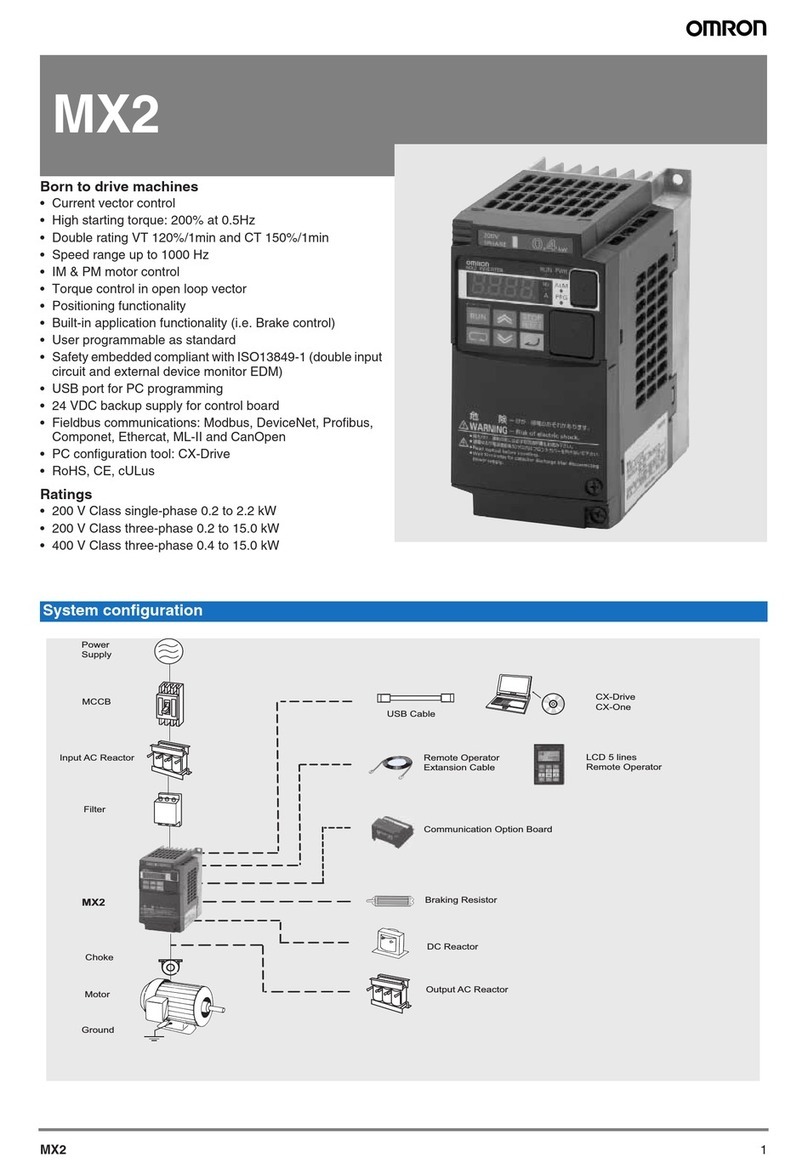
Omron
Omron SYSDRIVE MX2 SERIES datasheet
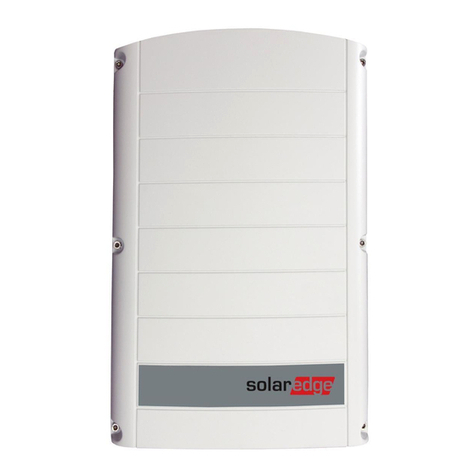
SolarEdge
SolarEdge SE2200 installation guide
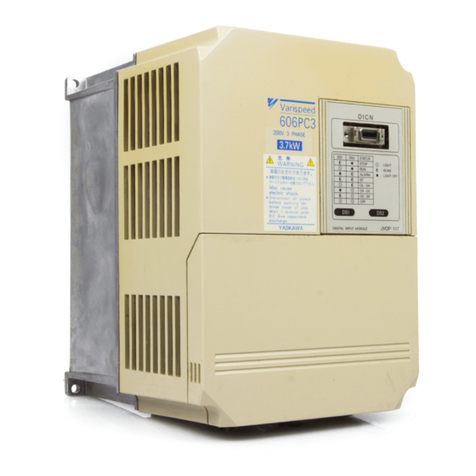
YASKAWA
YASKAWA Varispeed-606PC3 instruction manual
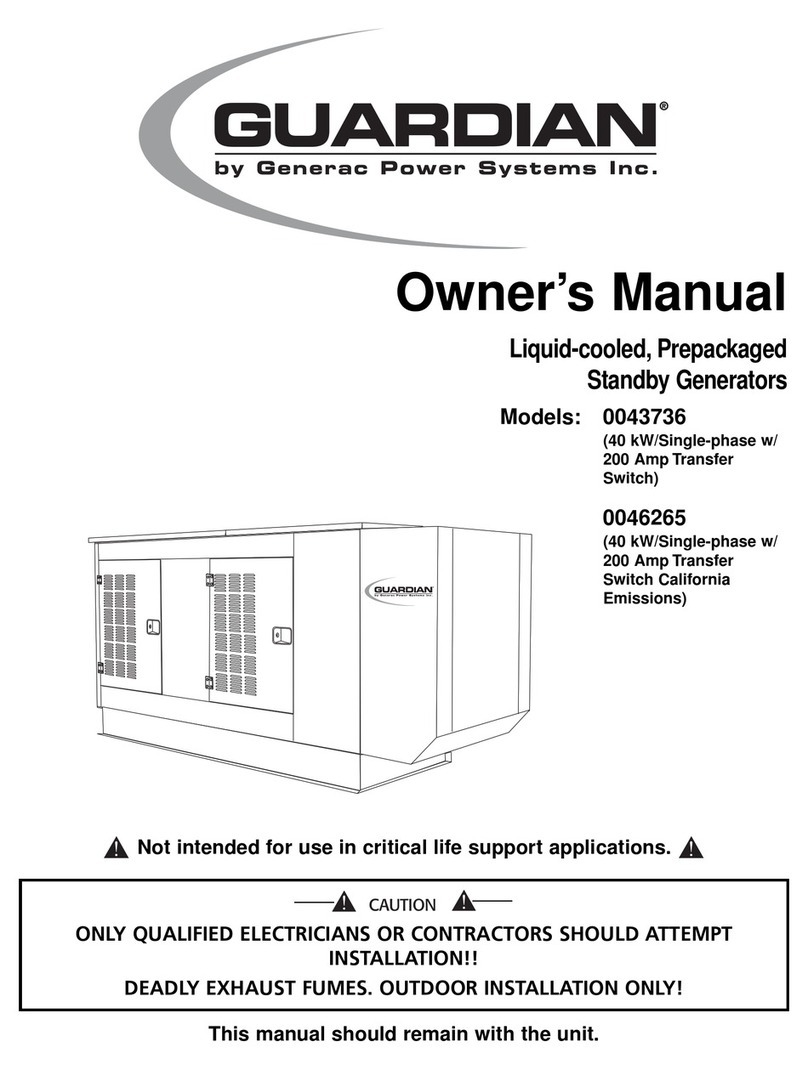
Generac Power Systems
Generac Power Systems Guardian 004373-6 owner's manual
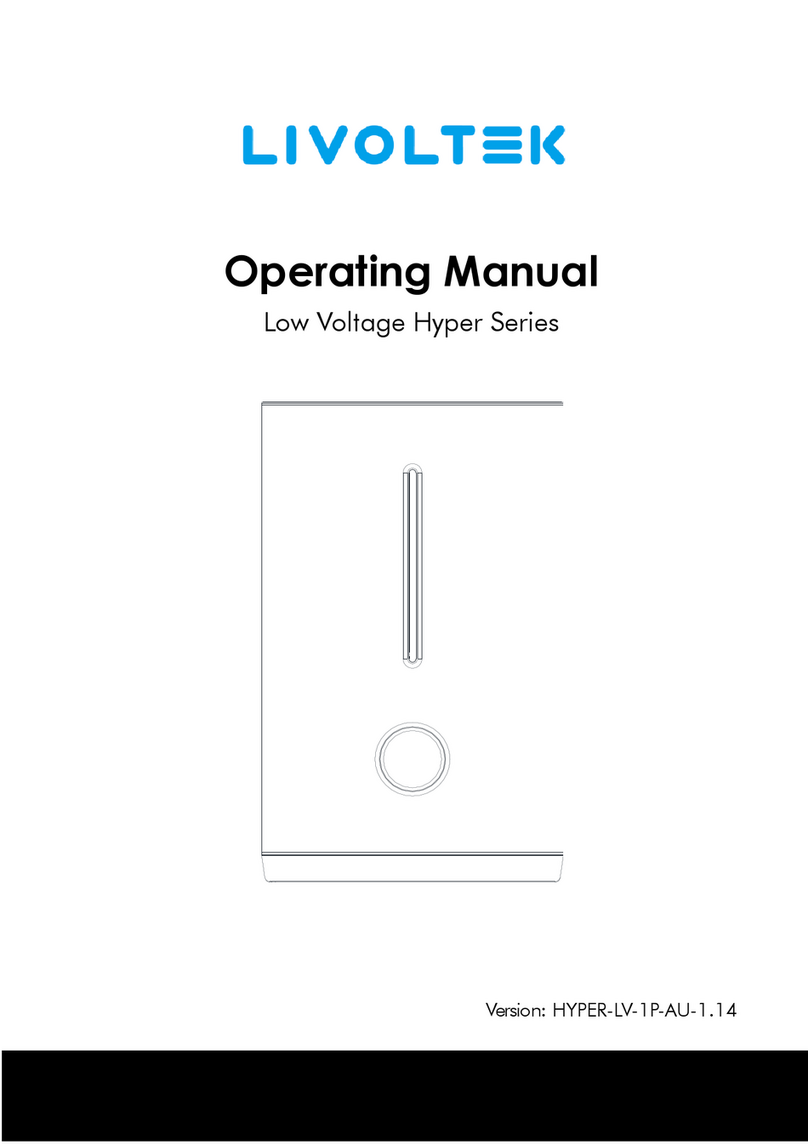
LIVOLTEK
LIVOLTEK Hyper Series operating manual
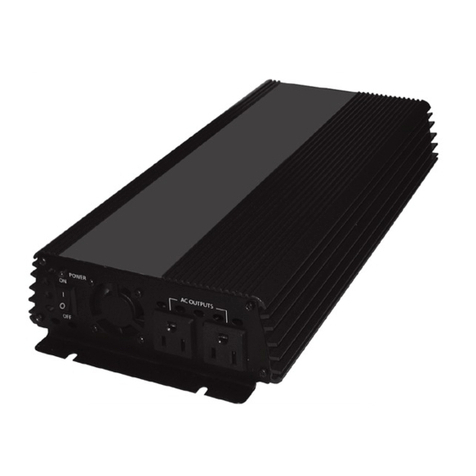
Chicago Electric
Chicago Electric Power Systems 93761 Assembly and operating instructions
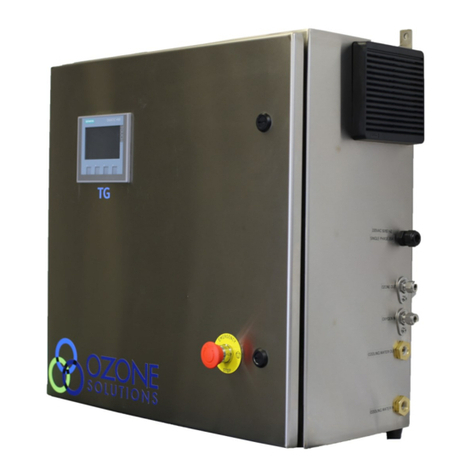
Ozone Solutions
Ozone Solutions TG Series Installation & operation manual
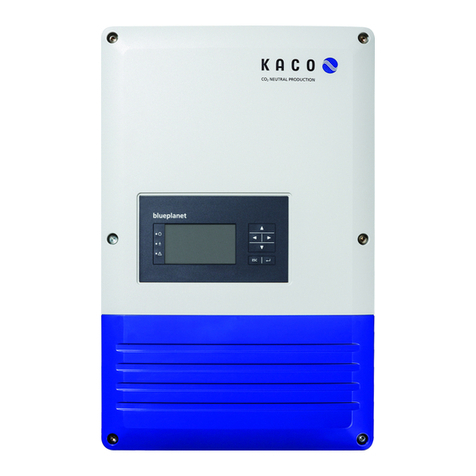
Kaco
Kaco blueplanet 20.0 TL3 operating instructions

Mitsubishi
Mitsubishi FR-A7NC instruction manual

Husky
Husky HSK065HD Owner's manual & warranty
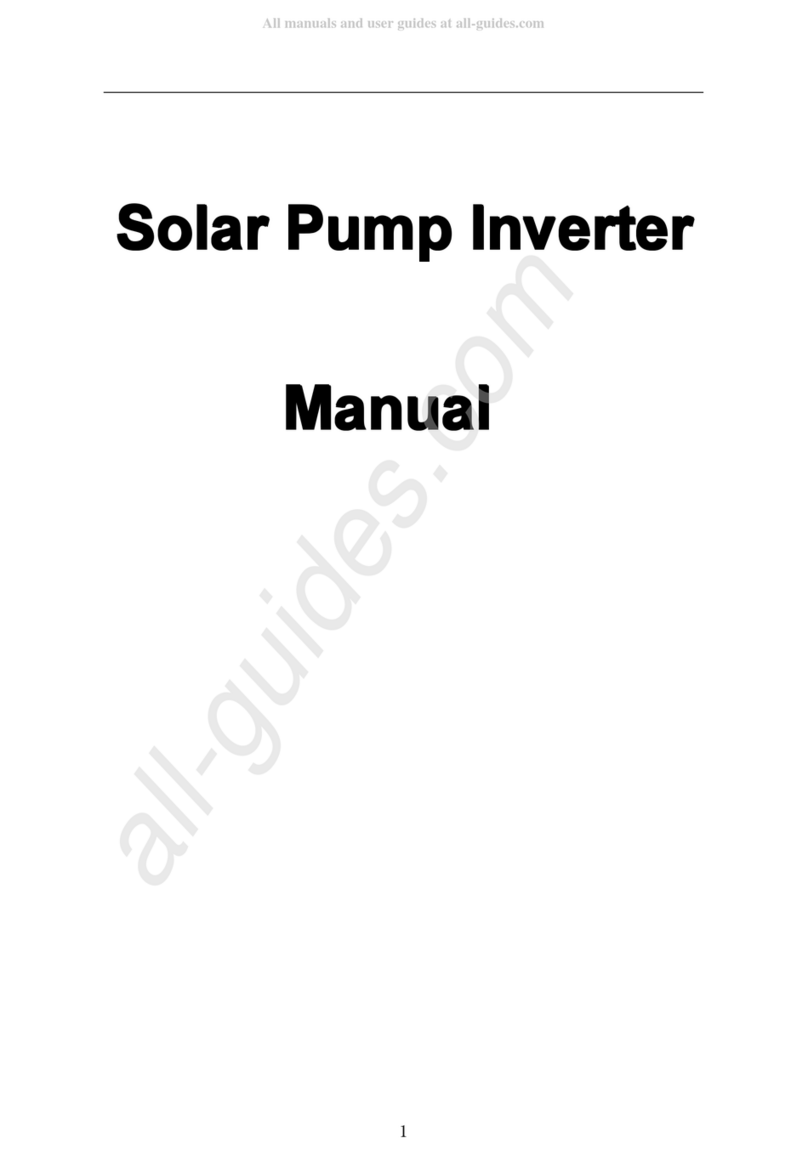
Setec
Setec 750L manual
